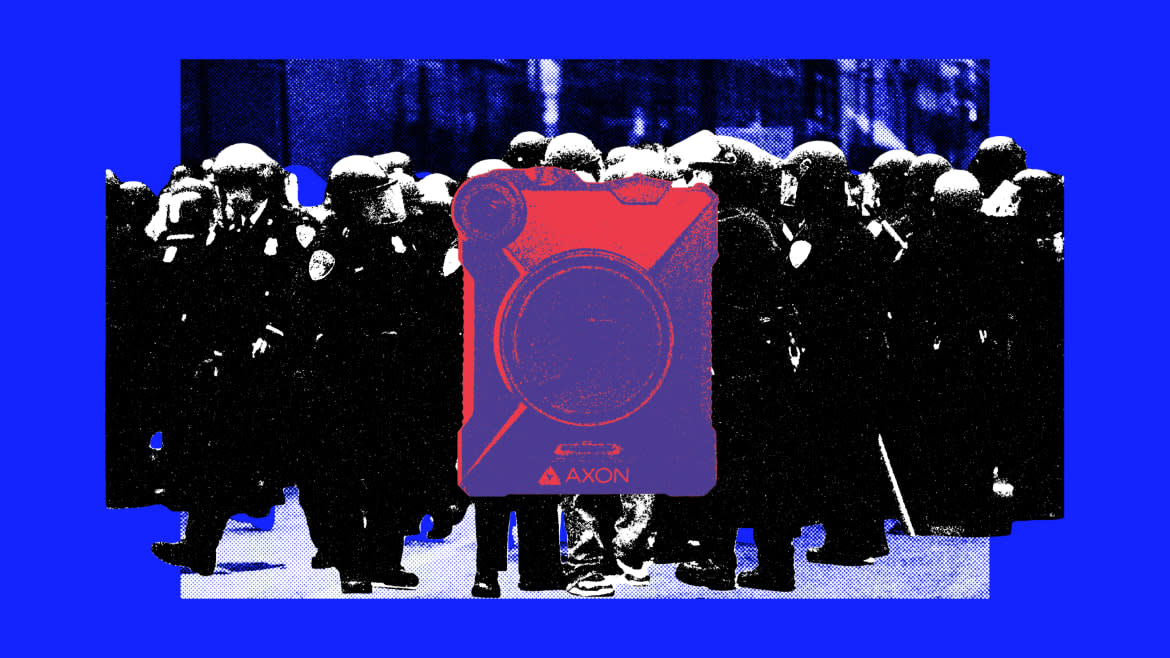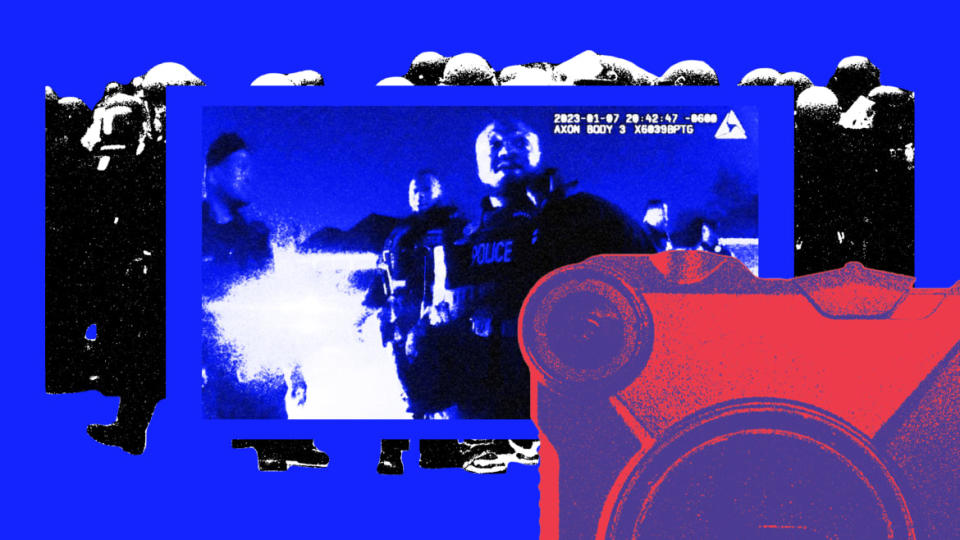Bodycams Can Help Abusive Police Spread ‘Copaganda’

- Oops!Something went wrong.Please try again later.
“Give me your hands!”
“Give me your fucking hands!”
These and similar phrases were uttered dozens of times by the five Memphis police officers who engaged in a deadly assault on Tyre Nichols, an unarmed African American male. The repeated demand, which was picked up on the police bodycam video, can be a bit puzzling for the viewer. After all, Nichols’ hands are clearly visible throughout the interaction. In fact, at one point he appears to be offering his hands to the enraged officers.
Tyre Nichols’ Mom Takes Aim at Lawmakers in Eulogy for Her Son
Still, even when Nichols’ hands are bound, unable to offer any meaningful physical resistance, the officers can be heard making the same demand.
Why?
The answer to this question is not only fascinating but sets the stage for the next phase of our media-obsessed national narrative.
We have been sold on the idea that police bodycam video tells the truth. Shot in the moment, presented in a raw, unedited form, and unblemished by the subjective input of a producer or narrator telling us what to see or think, bodycam video is supposed to offer police departments transparency and promote accountability.
But what happens when it is the police officers who are telling us what to see or think not after the fact, but while the video itself is being shot? Can a bodycam video still be seen as representing an unvarnished truth?
Hardly, and certainly not here. With the officers shouting “Show us your hands,” we, as the viewer, are led to believe that Nichols may have a weapon, giving police the shield of probable cause. And since the video is crudely shot—the image bouncing and distorted as the officer runs, the sound moving in and out—we may be confused to the point where even if we can see Nichols’ hands and even if we might be inclined to believe that he is being cooperative, we are forced to admit that we are not there, and the officers are.
Bodycams Don’t Work. Civilians Recording Police Does.
Surely, in all the confusion, these trusted public servants must see something that we don’t see.
But what if that isn’t true? What if the brotherhood of the blue has collectively understood that bodycam video best supports their point of view and, more important, protects their jobs, when they “perform” for the camera, even if that “performance” distorts the truth? In essence, what if, when under the watchful eye of a bodycam, police officers decide to gaslight us?

Memphis Police Department officers appear on body camera footage during the arrest and assault of Tyre Nichols on Jan. 7, 2023.
Consider, for instance, that the bodycam offers one sort of evidence toward understanding what happened to Tyre Nichols. But surveillance video—in this case, attached not to a body but to a nearby pole—offers the most damning.
It is from that vantage point where we clearly see Nichols being held down while an officer kicks him like he is a football. Unlike the bodycam footage, there is no audio feed to even suggest that the police are addressing a “show us your hands” threat. There is no reason to even consider it.
In our book, Seen and Unseen: Technology, Social Media, and the Fight for Racial Justice, we outline the role that technological achievement has historically played in the story of race in America: Frederick Douglass’s obsession with still photography as a means of demonstrating Black dignity; D. W. Griffith’s reclaiming of the Lost Cause narrative in the first ever feature-length film, Birth of a Nation, a racist re-telling of the story of the Civil War; the photojournalists of the 1960s becoming the storytellers of the Civil Rights Movement.
We were inspired to write our book when we recognized another episode of that history in the uproar that accompanied the release of the video of George Floyd dying under the pressure of Derek Chauvin’s knee while Floyd was pinned helplessly to the pavement on a Minneapolis street.
‘Riotsville, USA’ Shows the Birth of Police Militarization
Tellingly, the most compelling video of George Floyd’s murder did not come from a police bodycam, but from 17-year-old Darnella Frazier who, on her way to the store to buy some snacks for her sister, pulled out her cellphone and recorded the scene. If there had been no Darnella Frazier, would the Minneapolis officers’ bodycam video of George Floyd have sparked international outrage and condemnation? Likely not.
There is one simple truth in this for us, as a society, to accept: Victims don’t have bodycams.
The closest we come to a victim bodycam is the courageous bystander with a cellphone; that, and the disinterested surveillance camera propped onto a neutral site. Absent either of these, the police narrative remains the only game in town, and it is too often a brutal and unjust one.
When news came that the Memphis Police Department would be dropping the video of Tyre Nichols’ beating, the moment galvanized the nation’s attention in a way that felt more than a little voyeuristic. Gruesome though it promised to be, the release of the video became an event in and of itself, not unlike the ones that white supremacist mobs attended during Reconstruction to witness the lynching of black men and women.
Images predominated then, too. Along with charred body parts, postcards offering pictures of men hanging from trees were disseminated as souvenirs, the latter often inscribed with a racist verse celebrating the killing. It was only through the work of the courageous Black journalist Ida B. Wells that these same pictures were later reframed to command outrage. Through scrupulous research, Wells was able to disprove many of the charges against the men and tie the community bloodlust to a cult of white supremacy. Wells not only coldly laid out the evidence of Black innocence; she also provided a detailed description of white barbarism. Through her work, Wells offered, one might say, “bystander video” before there was bystander video.
Right now, the consensus, driven by the video, is that the Memphis police officers behaved criminally and should be charged with second degree murder. But over the next few days and weeks, we will likely be introduced to yet another reframing of the evidence.
Just as there was with George Floyd, Eric Garner, Trayvon Martin, and for that matter—long before social media—the 14-year-old Emmett Till, there will be a steady campaign of “copaganda” and victim shaming. Indeed, it’s already begun.
Turns Out You Actually Can Hold Killer Cops Accountable
Along with the routine condemnation of the officers as “thugs,” voices on various media platforms have claimed that Nichols was “high as a kite” and “tried to take an officer’s gun.” Others have argued that if Nichols “…had just complied with the officers none of this would have happened. But for some reason Blacks always resist arrest.” In the face of such organized misinformation and disinformation, the bodycam video will serve multiple masters.
Yet the fact is, like all technology, body cameras are only as valuable as the uses to which we put them. For this reason, we must resist the urge to view police footage as an unimpeachable witness or an objective court of appeal. Rather than romanticizing or fetishizing body cam technology, we must view it for what it is: a potentially useful but undoubtedly flawed tool.
No, body cameras will not save us from violent or corrupt policing. More often than not, they will not even expose it. To accomplish such lofty but worthy goals, we must do more than produce more technology. We must transform the society in which the technology is produced.
Get the Daily Beast's biggest scoops and scandals delivered right to your inbox. Sign up now.
Stay informed and gain unlimited access to the Daily Beast's unmatched reporting. Subscribe now.
